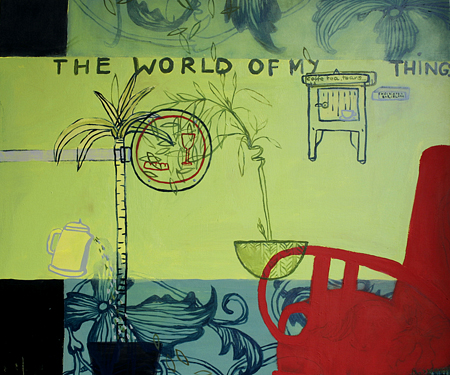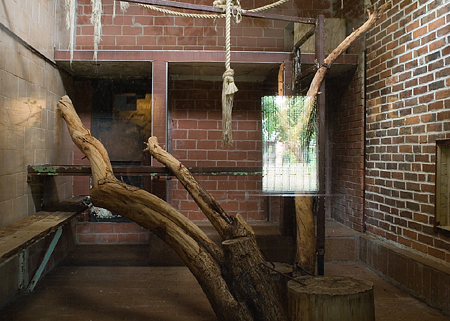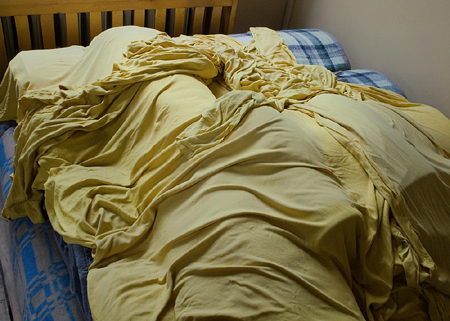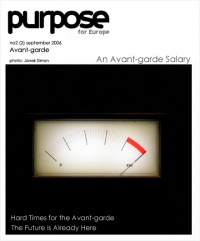
Career in Culture
Souls agreement
You have developed a project entitled „Incidents” – tell us about it. Why were “Incidents” developed in Cieszyn Castle? You live and work in Cieszyn, co-operate with artists in the Czech Republic and England – what is this cooperation like?
Agula: “Incidents” were born in our heads during artistic residency in the town of Clitheroe (North England). We already knew that we wanted to return to Poland and make something new. Something that would give young artists a chance to go beyond the dull reality of our country – something to help them build up their artistic identity. In December 2004 Tom was finishing a huge metal object ‘ho_use’ (which almost crushed on him), and at Manchester Art Show I met Anna from the Art House. Together with Keith (an English businessman who can understand art almost as easily as numbers) we, step by step, started developing our “incidental plan”. And thus “Incidents” - the program of artistic residencies - was created in cooperation with Silesian Castle of Art and Enterprise in Cieszyn, KaSS “Strzelnice” and with the Art House in the UK.
In the summer, in the first half of June, and international group of artists from Poland, Czech and Great Britain came to the castle to work and implement their projects in the context of the divided town of Cieszyn. We started our first project of artistic residency: “Incidents – Scarring”. Brijesh Petel came from London. He set up a provisional photographic studio on the Bridge of Friendship and for hours was encouraging the passing by tourists to portrait photographs. In that way he took anonymous pictures of individuals, without dividing them into Czechs and Poles, into better or worse. Samantha Donnelly from Manchester was fascinated by the River Olza – the metaphorical and visual boarder line of the river. The combination of ephemeral and very feminine objects made of paper was inspired by subtle boarders between various zones. Petra Abrahamova from Jablonkovo kept Little Visual Diary – whether it rained, whether the sun was shining, about the Red Incidental Dog that accompanied us throughout our residency. Jirka Coubal from Prague stuck his little photos in different parts of the town; the pictures “conserved fragments of time”. Wojtek Iskierka started looking for stereotyped way of thinking – he didn’t reveal in which part, Czech or Polish, he found more of it. His photographs show everyday life of people on both banks of the Olza. Gosia Nizio³ek in her project “12%” impressed matzevahs, the only relics of Jewish community that lived in Cieszyn before the World War II, in ceramic clay. With the gesture of rolling up the clay tombstones she showed the irreversibility of history. Daniel Hryciuk in his project “tam jest lepiej-tam je lip” with the system of arrows on both sides of the town showed a passer-by round and round, “in a game leading to nowhere, a game which lets you down and finally makes you go your own way”. His installation – a fridge full of 96% spirit crashed into a wall of popcorn - was inspired by Czech-Polish “tourist-gastronomic preferences”. And of course Grzesiek Majchrowski – he will stay in the memory of Cieszyn dwellers as the artists who, for the first time in history, attempted symbolic sewing up of the River Olza. Assisted by Czech and Polish artists (and Cieszyn firemen!) he connected the Olza using blue fabric. He wanted the river to be “the jewel of the land and communities” and not “a line that divides the town and the nations”.
It was with him, with Ania Górska, the team of the Castle and the KaSS people that we developed “Incidents – Scarring”. An exhibition, open on July 7th in the display hall of Silesian Castle of Art and Enterprise, presented works of the whole international group.
This October the project „Incidents – Crossing Borders“ will continue; KaSS „Strzelnice“ in Czech Cieszyn and Silesian Castle of Art and Enterprise will be the main organizers. It will be another edition of Incidents on the Olza, another residential opportunity for young artits, students and graduates of art schools. From October 15th to August 15th eight artists, selected in a competition, will be provided with studios, materials, accommodation and board to work jointly in the context of the divided town of Cieszyn and Czech Cieszyn. One of them will create another object of public art, this time on the Czech bank of the Olza. To enter the competition for international artisitic residency you have to submit five works, your cv and the description of the project to be implemented during the residency. In October we will select an international group that will jointly carry out the next edition of „Incidents“.
For further information on the competitions for international residencies and art projects within „Incidents“ please visit: www.incydenty.pl

Agula Swoboda
You lived and worked in England for two years, you owned a company there – how is it to run a company in England, what are the formalities and monthly costs of that?
Agula: Running a company in England is as simple as making tea with milk: you chose a name and a profile, you register on-line, each month you pay insurance (ca.15 pounds), collect receipts (there are no invoices!) and account for the expenses within the fiscal year - from April to March (your tax statement has to be submitted by September 30th, and the tax paid by January 30th of the next year). Up to 4000 pounds you don’t pay any taxes, up to 6000 – 10%, then 20%. You have to earn really a lot to enter the magical 40% income tax threshold.
In England you ran an art centre – what was it like?
Agula: We visited the Islands at the invitation of Keith Shortley I have told you about. For two years we worked for Lancaster Foundation in the town of Clitheroe in the north of England, not far from Manchester. The Foundation had bought a beautiful cinema called “The Grand”. In the basement there was an antinuclear bunker built in the times of the iron dictatorship of Ms Thatcher. We made it into a small centre of contemporary art and called simply “UnderGrand”. In “UnderGrand” we provided workshops on sculpture, painting, and made our own art as resident artists; we also made a few interesting joint exhibitions – with a group of international artists who worked in the north of England. Just before our return to Poland the Foundation closed the old cinema, so we had the whole building for ourselves.
We were the curators and the participants of the last exhibition with a meaningful title: “The Last Picture Show”. The space gained a magical dimension: we all were in a cinema and we created our own “film”. Multipart. Tom photographed the space of the cinema and showed, on a side screen, pictures of the clouds over Clitheroe and the first owners of the cinema, and a film – a walk between red velvet chairs with us sitting as once Mr and Mrs Coolen (the founders of the cinema Grand) were. Downstairs, in the gallery, I made my own little cinema for 20 people – I painted the walls black, I put red, velvet chairs and hang my own screen with a film painted on the canvas – “There Will Be No Fear”. Lee Patherson made a sound installation. On the floor he placed speakers with the recorded and processed sound of the main power generator in the bunker. The sound was of very low frequency, not audible by man. The only signs of the presence of the sound were black, lead balls bouncing on the speakers’ membranes. Jacob Cartwright and Nick Jordan made a multimedia composition of a black and white film and animated crows. Magda Stawarska-Bevan, in her sound installation, performed the moment “Before and After”. Sitting in red, cinema chairs you could hear the steps of people entering the cinema, broken sentences, the sound of unwrapped sweet papers, creaking chairs, and of the silence when everybody has gone. Dave Gryfiths put three little screens in the old projector cabin. On each a film was shown – the directors’ cut of all the errors, dirt, and jagged film frames.

Tom Swoboda
Have you managed to start a company in Poland?
Agula: Quite recently we closed down our company in England and we haven’t started anything in Poland yet. A few days ago an opportunity of funding appeared within a project called ‘two and a half steps to business’ carried out by GARR (Activity 2.5, funding for small enterprises). We waited for the right moment and I think that soon we will manage to “reactivate” 4Dart – our good, old English company that of course dealt with art, but also with art and commercial photography, with graphic design, multimedia visualizations and with advertising campaigns.
Do you acquire external funding for your projects? Where from and how?
Agula: Our projects “Incidents-Scarring” as well as “Incidents-Crossing Borders” commencing soon are co-financed by the European Fund for Regional Development under the Programme Interreg IIIa.

Tom Swoboda
You are a couple of artists, what is it like to live with an artist under one roof, to raise children…?
Tom: What is it like…tell us Agula?
Agula: Fine, very fine. There is something very precious between us – I call it “the communion of souls”. You don’t have to explain much, to speak or wave your hands. Some magic spiritual bond, a gift from God. Besides, Tom supports me when everything sucks, both art and life. And I am a fan of his art. Our little Nadia very often plays around when I am working or she sits on Tom’s lap and they are looking at his photographs together. In Cieszyn a horrible monument of “A Brave Silesian Woman” was put up and once, while taking a walk, we called it “rubbish”. Now, whenever we pass the monument, our little girl, disregarding the people looking, shouts: Mummy, look - rubbish!”
Do you consider yourselves avant-garde artists?
I can’t consider myself an avant-garde artist. As for me, only one aspect may suggest this “avant-gardism” – the search for even fuller artistic expression, breaking cliches I find on my way, decoding the present time – decoding myself. This “avant-gardism” (although it is not quite the right term) rather concerns the quiet work that is going on inside of me, the investigation into my position between the earth and the sky. Without the diagnosis who I am and why I do what I do there won’t be any specific language to use – there will be only a momentary stay in some second-hand space which can be called art…maybe avant-garde – whatever.

Agula Swoboda
What is the combination of avant-garde and enterprise like? Can you combine those two concepts?
Tom: Not only you can but you must! Otherwise you are starving. I think it’s not arrogant, and it’s very businesslike when an artist can earn a living from his art. Most artists in the West work in that way and they can’t see any dissonance in that. These two things are obvious and complementary – art and art market.
Your works are shown in Poznañ gallery Arsenal, why there and what does it mean to you?
Tom: Our works were selected for the exhibition entitled: “Interieur”. These are four displays (in four Polish towns – Bielsko-Bia³a, Poznañ, Toruñ and £od¼) of works by the young generation of artists who have connections with Bielsko-Bia³a and the region. The exhibition invited artists whose works are inspired by the whole set of meanings of private space – from home, identity, family to the space of our consciousness/sub-consciousness where we sometimes hide our most gloomy stories.

Tom Swoboda
What are your plans for the nearest future?
Tom: I am working on a new project „4 corners“. It is about defining the specificity of „places“ through the analysis similar to that in haiku poems, but with a different visual effect. It will be a collection of objects, notes, large format photographs. I think that I will spend the nearest months working on it. Next year I would like to show it in a few palces in Poland and England. In the meantime we, Agula and I, will certainly continue „Incidents“, raise our daughter and meet our friends.
Agula: Apart from investing in our artistic activity, in our next step will be establishing a family and friends independent organization „Incidents“ that will carry out a long-term international programme of artistic exchanges and other interesting projects on contemporary art. We want to cooperate with artists and selected art organizations. Together with Keith Shortley (Sector 3) we have already applied for support from the cross-border programme Interreg IIIa. We are waiting for the results.
Whereas „Incidents“ will always support artists on the threshold of career – will go beyond stereotyped way of thinking and dull reality which is the killer of dreams.
Thank you very much.
Check the archive

nr 25 October 2006
theme of the issue:
AVANT-GARDE
< spis treści
Article
From the Editors
Presentation
Janek Simon
Analysis
Avant-garde hard time - Artur Zaguła
Career in Culture
Souls agreement - interview with Agula i Tom Swoboda
Culture Industries
Avant-garde salary - Artur Zaguła
Workshop
To create and live - Maciej Mazerant
Young Culture
Something new - conversation with Jankiem Simonem
On the margin
Avant-garde - conversation with custodian Paweł Jarocki





